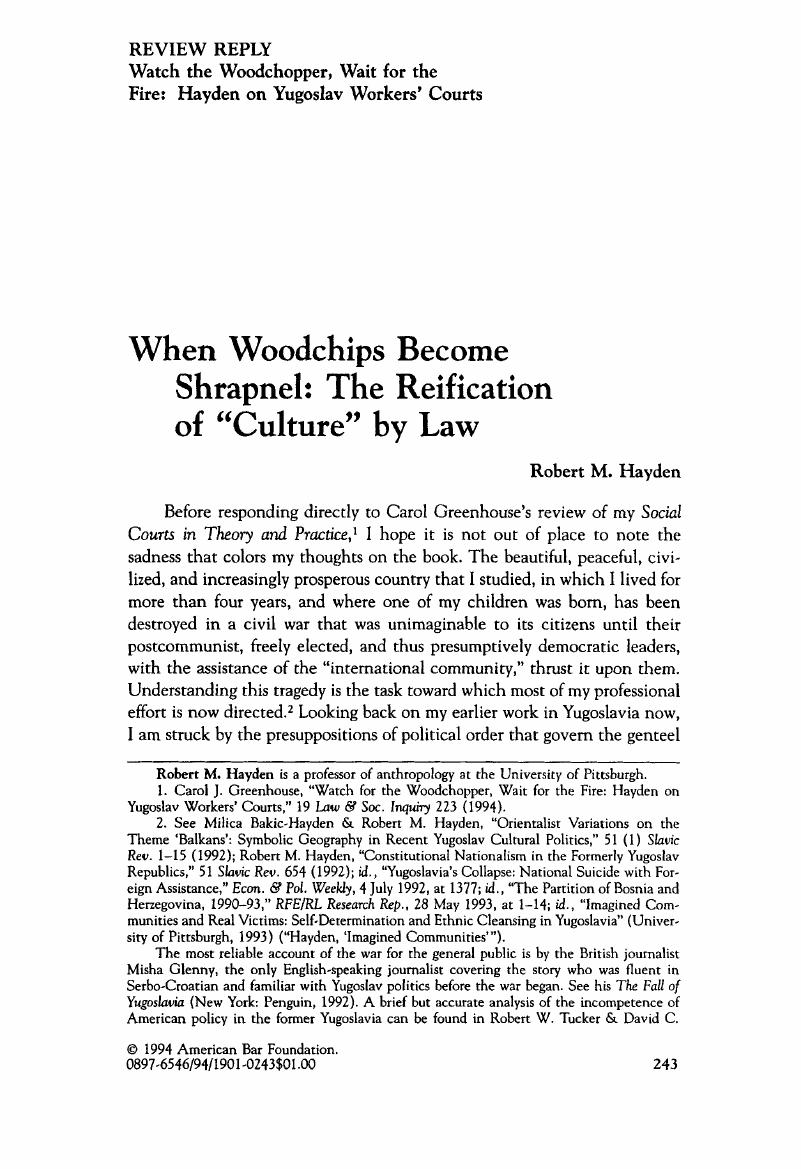No CrossRef data available.
Published online by Cambridge University Press: 27 December 2018

1 Greenhouse, Carol J., “Watch for the Woodchopper, Wait for the Fire: Hayden on Yugoslav Workers' Courts,” 19 Law & Soc. Inquiry 223 (1994).CrossRefGoogle Scholar
2 Bakic-Hayden, Milica & Hayden, Robert M., “Orientalist Variations on the Theme ‘Balkans’: Symbolic Geography in Recent Yugoslav Cultural Politics,” 51 (1) Slavic Rev. 1–15 (1992); Hayden, Robert M., “Constitutional Nationalism in the Formerly Yugoslav Republics,” 51 Slavic Rev. 654 (1992); id., “Yugoslavia's Collapse: National Suicide with Foreign Assistance,”Econ. & Pol. Weekly, 4 July 1992, at 1377; id., “The Partition of Bosnia and Herzegovina, 1990–93,”RFE/RL Research Rep., 28 May 1993, at 1–14; id., “Imagined Communities and Real Victims: Self-Determination and Ethnic Cleansing in Yugoslavia” (University of Pittsburgh, 1993) (“Hayden, ‘Imagined Communities’”). The most reliable account of the war for the general public is by the British journalist Misha Glenny, the only English-speaking journalist covering the story who was fluent in Serbo-Croatian and familiar with Yugoslav politics before the war began. See his The Fall of Yugoslavia (New York: Penguin, 1992). A brief but accurate analysis of the incompetence of American policy in the former Yugoslavia can be found in Tucker, Robert W. & Hendrickson, David C., “America and Bosnia,” 33 Nat'l Interest, Fall 1993, at 14–27. My own thoughts on the matter can be found in Hayden, Econ. & Pol. Weekly, 4 July 1992 supra.CrossRefGoogle Scholar
3 Greenhouse's title image of the woodchopper has a jarring resonance for me that others will not feel: as constitutional negotiations for an independent Bosnia and Herzegovina collapsed in March 1992, the leading independent Belgrade paper, Borba, used a drawing of a log splitting into three segments at the head of each day's reporting on the division of the republic.Google Scholar
4 E.g., “Balkan,”“East European,”“Central European,”“European,”“Western”; see Bakic-Hayden & Hayden, 51 (1) Slavic Rev.Google Scholar
5 Hayden, “Imagined Communities”.Google Scholar
6 Hayden, Robert M., “Cultural Context and the Impact of Traffic Safety Legislation: The Reception of Mandatory Seatbelt Laws in Yugoslavia and Illinois,” 23 Law & Soc'y Rev. 283 (1989).Google Scholar
7 Hayden, , 51 Slavic Rev.; id., Econ. & Pol. Weekly, 4 July 1992; id., “Imagined Communities.Google Scholar
8 The historical distinction here is actually a bit forced. Disruption of everyone else's generalizations was long a staple of anthropological writing, from at least the time of Malinowski on the oedipal complex and Margaret Mead on adolescence.Google Scholar
9 Roeder, Philip G., “Soviet Federalism and Ethnic Mobilization,” 43 World Politics 196 (1991). On the other hand, the potential fragility of federal structures under any circumstances is an important point to bear in mind, since the disintegration of federations into warring separate states was a nightmare haunting the writers of the Federalist Papers. Their grim predictions of the consequences of the disintegration of a federal structure proved accurate in fact, in America in 1861, Yugoslavia in 1991, and parts of the former Soviet Union since 1992.Google Scholar
10 Edward Said, Orientalism (New York: Random House, 1978).Google Scholar
11 See, e.g., James Clifford, The predicament of Culture (Cambridge, Mass.: Harvard University Press, 1988).Google Scholar
12 Hayden, , 51 (I) Slavic Rev. (cited in note 2).Google Scholar
13 On the misleading tendencies of “ancient hatreds” as a means of explanation, see Susanne H. Rudolph & Lloyd I. Rudolph, “Modem Hate,” New Republic, 22 March 1993, at 24–29. The “clash of civilizations” thesis (Samuel P. Huntingdon, “The Clash of Civilizations,” 72 (3) Foreign Affairs 22 (1993)), which transforms the immutability of “tradition” from individual cultures to the larger “civilizations” that supposedly determine them, seems almost a perfected parody of the kinds of analyses exposed by Said's brilliant polemic on Orientalism (1980). Apparently, the author did not hear the words of the Muslim President of the ill-fated Republic of Bosnia and Herzegovina at the London Conference on the Former Yugoslavia, 26 Aug. 1992: “Bosnia-Herzegovina is a European country, and its people are European people. Even the evil inflicted upon us has not come from Asia, but has a European origin. The aggressor has mixed two poisons in himself: fascism—which is racism and extreme nationalism—and bolshevism—total absence of a feeling for law and human rights. Both are European-made products”.Google Scholar
14 The description of laws mandating cultural identity as “the apotheosis of the nation state” is borrowed from the title of a paper by Professor Vojin Dimitrijević of the Belgrade University Faculty of Law (1992). John Borneman's use of legal materials as data for the analysis of constructions of the German “nation” came to my attention too late to be used here. See his Belonging in the Two Berlins: Kin, State, Nation (Cambridge: Cambridge University Press, 1992), and “Uniting the German Nation: Law, Narrative and Historicity,” 20 Am. Ethnologist 288 (1993).CrossRefGoogle Scholar
15 Hayden, , 51 (1) Slavic Rev., and id., “Imagined Communities” (both cited in note 1).Google Scholar
16 Dams, 2 July 1993; cited in Stan Markotich, “Ethnic Serbs in Tudjman's Croatia,” RFE/RL Research Rep., 24 Sept. 1993, at 28–33 (1993). The translation is by Markotich, but the emphasis is mine.Google Scholar